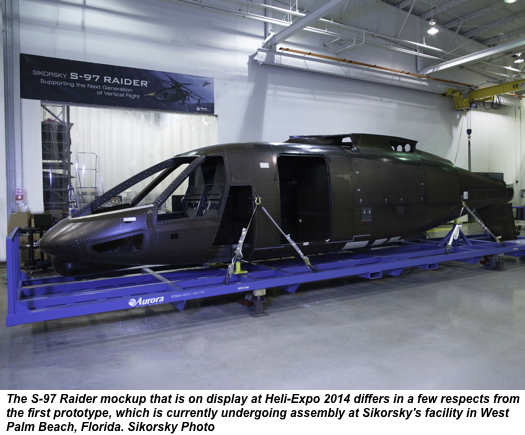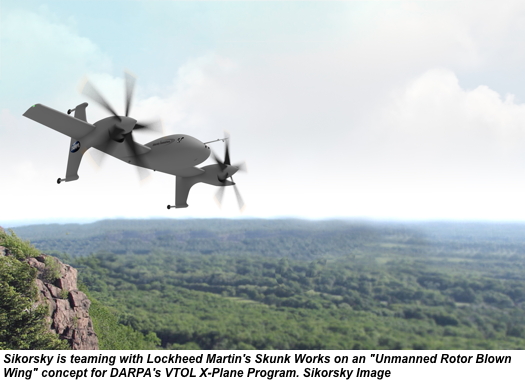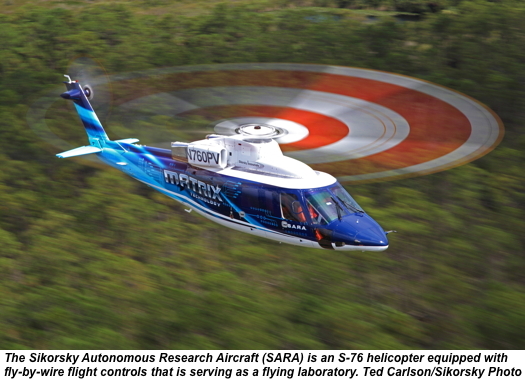Sikorsky Aircraft specializes in helicopters that are large and technologically complex (some of which, like the CH-53K, are as large and complex as they come). Consequently, the company unveils new production helicopters only infrequently, particularly when it comes to the commercial market. Yet the Sikorsky exhibit is consistently among the most exciting displays at Heli-Expo, and this year is no exception.
Visitors to Sikorsky’s booth in Anaheim have seen examples of the company’s flagship commercial helicopters, including an S-92 owned by Milestone Aviation and leased to CHC Helicopter, and an S-76D operated by Bristow Group, the launch customer for the D model. But they’ve also gotten a glimpse of the exotic: a mockup of the S-97 Raider that is being developed from the high-speed, coaxial rotor X2 technology demonstrator that made a head-turning appearance at Heli-Expo 2011.

Vertical spoke with Sikorsky prior to the show to get an update on the Raider, the first prototype of which is currently undergoing assembly at Sikorsky’s facility in West Palm Beach, Fla. “The assembly’s progressing really well,” said Steve Weiner, chief engineer for Sikorsky Innovations, the technology development division that created the X2 and is now leading development on the S-97. According to Weiner, the Raider is benefiting from the same digital design and modeling process that has facilitated development of the CH-53K, creating a virtual three-dimensional model of the aircraft that can be used to resolve engineering conflicts before assembling the real thing. “The digital design and modeling is really reducing the time it takes to put it together,” he said.
Weiner said that the S-97 Raider is still on track to complete its first flight “before the end of the year,” although he did not provide more specifics. And he confirmed that Sikorsky is pressing ahead with the aircraft, despite the fact that the United States Army has delayed its pursuit of a modern helicopter for the Armed Aerial Scout (AAS) program. The AAS program aimed to replace the Army’s fleet of OH-58D Kiowa Warrior helicopters with either a new-start program like the Raider, or one of the commercial-off-the-shelf helicopters that were also offered as contenders. In January, however, the Army announced that, due to budget constraints, it would be leveraging its existing fleet of AH-64 Apache helicopters in combination with unmanned systems as an interim solution for the armed aerial scout role.
“There is still a long-term requirement for an armed aerial scout,” said Weiner, explaining that Sikorsky is betting on the Army re-evaluating its requirements in the future. He said the company was encouraged by the outbrief it received after meeting with the Army as part of the AAS request for information process: “We had effectively no deficiencies. . . . I think they regarded us from a risk level as low.”

Meanwhile, work is also progressing on the Defiant, Sikorsky and Boeing’s joint proposal for the Army’s Joint Multi Role/Future Vertical Lift (JMR/FVL) program. This multi-stage initiative aims to eventually replace the Army’s existing AH-64 and Sikorsky H-60 Black Hawk helicopters with a single platform — making it a critical competition for both companies, who derive a significant portion of their revenues from these workhorse models. Like the Raider, the Defiant is also based on Sikorsky’s coaxial-rotor X2 technology, which offers high speed while retaining and even enhancing the maneuverability of conventional helicopters.
As cutting-edge as X2 technology is, however, Sikorsky is already looking beyond it. In December, the company announced that had been awarded $15 million in funding by the U.S. Defense Advanced Research Projects Agency (DARPA) for Phase 1 of the Vertical Take-Off and Landing Experimental Aircraft (VTOL X-Plane) program. Sikorsky is teaming with Lockheed Martin’s Skunk Works on what it describes as an “Unmanned Rotor Blown Wing” concept, which aims to meet DARPA’s requirements for an experimental aircraft capable of exceeding 300 knots, with a hover efficiency of 75 percent or better, and with a cruise lift-to-drag ratio of 10 or more. (As Weiner put it, “DARPA comes up with projects that are DARPA-hard.”) Although Weiner wouldn’t disclose too many details about the Unmanned Rotor Blown Wing concept, he said that it uses technology beyond that in the X2, and “does not compete with armed aerial scout or JMR.”

The goal for the X-Plane program is to have a demonstrator flying by the end of 2017, although it’s hard to say when that technology might make its way into an operational aircraft. In the meantime, however, Sikorsky is making progress with an unmanned program — Matrix Technology — that may have more immediate practical applications. Sikorsky announced this autonomous flight research initiative last August at the Association for Unmanned Vehicle Systems International conference in Washington, D.C. There, it also unveiled the Sikorsky Autonomous Research Aircraft (SARA), an S-76 helicopter equipped with fly-by-wire flight controls that is serving as a flying lab for its unmanned technologies.
Igor Cherepinsky, chief engineer for the Matrix program, told Vertical that Sikorsky has completed Phase 1 of the program, which involved a basic demonstration of the aircraft’s flying capabilities over “tens” of hours (Sikorsky is not disclosing exactly how many hours the aircraft has flown). “In Phase 1, we wanted to demonstrate we could fly with precision and reliability,” Cherepinsky said, confirming that SARA demonstrated performance in Phase 1 comparable to that of a conventional fly-by-wire helicopter. The program has now moved on to Phase 2, which is focused on “perception” — the aircraft’s ability to sense and avoid obstacles, “flying low and fast with high levels of reliability,” Cherepinsky said. As part of this process, he added, SARA will demonstrate the ability to select landing zones and land autonomously. While he didn’t divulge specifics, Cherepinsky suggested that these landings will entail more than setting down in a large, open field. “It’s not just flat spots,” he said. “It’s about the mission and the humans around it.”
In this respect, Sikorsky is part of a larger industry effort to develop the reliable sense-and-avoid (SAA) technology that will allow unmanned systems to be more widely integrated into civilian airspace. In developing its own SAA system, it is drawing on well-established technologies such as light detection and ranging (LIDAR), but it is also exploring new tools. “The answer to sense-and-avoid is not one modality,” Cherepinsky said, noting that an SAA solution “has to be affordable as well. We feel that we’ve found that suite of technologies.”

According to Chris Van Buiten, vice president of Sikorsky Innovations, cargo transport stands out as one potential early application for the unmanned technology that is being developed in SARA (and in an unmanned Black Hawk helicopter that is close behind it in the Matrix program). “There’s a military application there, and we’re even talking to some commercial operators,” Van Buiten said, suggesting that unmanned vehicles on the scale of the S-76 or larger may prove attractive for moving cargo to offshore oil rigs. Although there are too many unknowns to say when such an application may come to fruition, Van Buiten said he believes it will be “definitely in the next decade. . . . It’s really based on the regulatory environment. I think the technology will be ready before that.”
While SARA is not in Anaheim this year, the broader philosophy that is driving the Matrix program is very much in evidence at the Sikorsky booth. At Sikorsky, autonomous flight has long been viewed as a continuum, with autonomous functions in manned helicopters at one end of the spectrum, and fully autonomous aircraft at the other. One example of how autonomous functions are already enhancing Sikorsky’s conventional helicopters can be found in its “Rig Approach” system, which is once again being demonstrated at Heli-Expo. This pioneering system allows S-92 operators to perform highly automated approaches to offshore rigs and platforms; in November of last year, PHI, Inc. became the first operator to use the system operationally. Eventually, the type of autonomous landing capability being developed in SARA could be used to fly automated approaches to full landings — a tremendous safety advantage for pilots in brownout, whiteout, and other reduced-visibility conditions. Other automated “apps” in manned cockpits could someday include automated entry into autorotation, or selections that automatically configure the aircraft to maximize cruise speed or minimize noise.
At the same time, technologies that Sikorsky has already developed for its manned aircraft are benefitting its unmanned program as well. For example, the same kind of sophisticated health and usage monitoring systems that are on the S-92 and S-76D will be critical in ensuring the extraordinarily high level of reliability that Sikorsky is targeting for its large unmanned platforms. “We’re not working on the cargo mission as a 25-pound payload — we’re very focused on the larger vehicles,” Van Buiten said. “With aircraft like these, you can’t afford to lose them once every thousand hours as you do with current UAVs.”
The same types of synergies that exist between Sikorsky’s manned and unmanned aircraft also exist between its commercial and military programs, and Van Buiten expects that Heli-Expo attendees will appreciate this crossover as well. Having seen the interest that the X2 technology demonstrator sparked when it was on display at Heli-Expo 2011, Van Buiten said he looks forward to “fun” conversations about the S-97 Raider with the show’s predominantly civilian attendees.
“To me it’s a very interesting discussion,” he said, “how could a commercial operator use the X2 Technology?”









